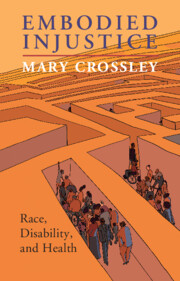Book contents
- Embodied Injustice
- Embodied Injustice
- Copyright page
- Dedication
- Contents
- Acknowledgments
- 1 Introduction
- 2 Health Disparities Based on Race and Disability
- 3 Biology’s (In)significance
- 4 Medical Mistrust
- 5 Maligned Mothers
- 6 Medicaid Preservation
- 7 Beyond Health Care
- 8 COVID Stories
- 9 The Busy, Troubled Intersection of Blackness and Disability
- 10 Conclusion
- Index
5 - Maligned Mothers
Published online by Cambridge University Press: 18 August 2022
- Embodied Injustice
- Embodied Injustice
- Copyright page
- Dedication
- Contents
- Acknowledgments
- 1 Introduction
- 2 Health Disparities Based on Race and Disability
- 3 Biology’s (In)significance
- 4 Medical Mistrust
- 5 Maligned Mothers
- 6 Medicaid Preservation
- 7 Beyond Health Care
- 8 COVID Stories
- 9 The Busy, Troubled Intersection of Blackness and Disability
- 10 Conclusion
- Index
Summary
Motherhood is often idealized. The dominant imagination admires idealized mothers for being loving, self-sacrificing, and nurturing. They are wise in discerning their children’s needs and supportive and generous in meeting them. Idealized mothers are strong and sensible, but always stand ready to offer a warm embrace. Television viewers may recognize the idealized mother in the iconic June Cleaver, whether they watched Leave It to Beaver in its original run during the 1950s and 1960s or in reruns.1 This traditional ideal is firmly grounded in twentieth century, middle-class, White, heterosexual norms of domestic motherhood.2 The ideal of good motherhood has evolved to admit the possibility that women who work outside the home might qualify as good mothers. But recent years have seen a resurgence of the traditional ideal of intensive mothering (which expects mothers to focus their energy and resources on child-rearing) and even competitive mothering (which describes antagonism between different approaches to mothering, often displayed in blogs or social media).3
Keywords
- Type
- Chapter
- Information
- Embodied InjusticeRace, Disability, and Health, pp. 101 - 127Publisher: Cambridge University PressPrint publication year: 2022

